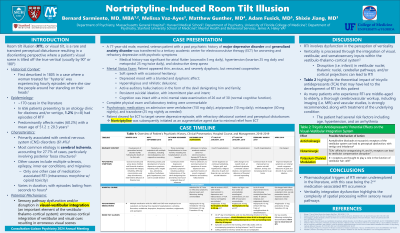Psychopharmacology and Toxicology
(145) Nortriptyline-Induced Room Tilt Illusion


Adam Fusick, MD, FAPA
Associate Program Director CL Psychiatry Fellowship
University of South Florida
Clearwater, Florida
Bernard Sarmiento, MD (he/him/his)
Resident Physician
Massachusetts General Hospital / McLean Hospital Psychiatry Residency Program
Cambridge, Massachusetts- MV
Melissa Vaz-Ayes, B.S.
Medical Student
University of Florida College of Medicine
Gainesville, Florida 
Matthew Gunther, MD, MA (he/him/his)
Clinical Assistant Professor
Stanford University
Palo Alto, California- SJ
Shixie Jiang, M.D.
Assistant Professor
University of Florida College of Medicine
Gainesville, Florida
Presenting Author(s)
Co-Author(s)
Background/Significance:
Room tilt illusion (RTI) is a rare, transient disorder of environmental perception characterized by a disorienting perspective where a patient’s visual scene is rotated off the true vertical (Sierra-Hidalgo, 2012). First described in 1805, most cases last for seconds to hours, and is the result of disruption in visual-vestibular integration (Kirsch, 2017). RTI is primarily attributed to conditions affecting the vestibular system and/or vestibular cortical areas, with posterior circulation cerebrovascular accidents (CVAs) being the most frequent cause (Sierra-Hidalgo, 2012). However, the occurrence of RTI during therapeutic use with a tricyclic antidepressant (TCA) has yet to be reported.
Case:
We present a case of nortriptyline-induced RTI in a 77-year-old male who was consulted on for treatment-refractory depression with psychotic features at an academic tertiary medical center. The patient was transferred for ECT and was being medically managed for atrial flutter, hypertension, and obstructive sleep apnea. Starting six days after initiating nortriptyline, the patient experienced RTI episodes characterized by a 90-degree visual tilt in his perception, as if the patient was standing on the wall looking down. These episodes were intermittent and occurred throughout his four-weeks of nortriptyline treatment. Neurological examinations, laboratory testing, and brain imaging were unremarkable throughout, ruling out other potential causes of RTI. The episodes ceased completely upon nortriptyline discontinuation and did not recur on two-month follow-up.
Discussion:
In cases such as this, especially in the hospitalized elderly population, an extensive neurological examination with imaging is critical, as most cases of RTI are attributed to CVA and vestibular pathology. Once a thorough neurological examination has been conducted, less serious and less common etiologies can be considered. The potential mechanisms of TCAs affecting visual-vestibular integration are broad and underexplored. In fact, medication-associated RTI in general has only been discussed in the context of opioid toxicity (Sierra-Hidalgo, 2012). TCAs’ neuromodulatory effects on the vestibulo-thalamo-cortical system, including anticholinergic, histaminergic, and noradrenergic actions, might have contributed to the development of RTI in this patient. Additionally, the inhibition of both norepinephrine and serotonin reuptake could also modulate a myriad of responses within the vestibular and thalamocortical pathways (Balaban, 2016).
Conclusion/Implications:
This case expands the spectrum of pathologies associated with RTI, highlighting its relevance to consultation-liaison psychiatry, particularly in managing elderly patients with risk factors for cerebrovascular accidents. It is important to be aware of medication-induced RTI and the pharmacological mechanisms of TCAs on vestibulo-thalamo-cortical function, when more common and more serious etiologies have been ruled out. This case underscores the vigilance that clinicians should have in complex patient presentations, considering the potential interaction between pharmacological treatment and underlying medical conditions.
References:
1. Clinical and imaging features of the room tilt illusion. Sierra-Hidalgo F, de Pablo-Fernández E, Herrero-San Martín A, Correas-Callero E, Herreros-Rodríguez J, Romero-Muñoz JP, Martín-Gil L. J Neurol. 2012;259:2555–2564.
2. Vestibular and visual cortex activity during room tilt illusion. Kirsch V, Keeser D, Becker-Bense S, Karali T, Ertl-Wagner B, Brandt T, Dieterich M. J Neurol. 2017;264:70–73.
3. Neurotransmitters in the vestibular system. Balaban CD. Handb Clin Neurol. 2016;137:41–55.
Presentation Eligibility: This work is expected to be published in the form of a case report prior to presentation. However, it has never been presented at another scientific meeting, and reinforces the need for clinicians to consider medication-associated room tilt illusion only after a thorough neurological examination with imaging has been conducted.
Diversity, Equity, and Inclusion: Medication-induced room tilt illusion (RTI) is a condition that can disproportionately affect elderly patients, including those from historically marginalized and disadvantaged groups. As RTI is often underrecognized and underreported, our study raises awareness of its occurrence in populations with complex medical and psychiatric histories. By exploring the pharmacological effects of tricyclic antidepressants on vestibulo-thalamo-cortical function, our research emphasizes the need for equitable and culturally competent healthcare practices that consider the unique vulnerabilities and healthcare disparities faced by marginalized elderly populations.

